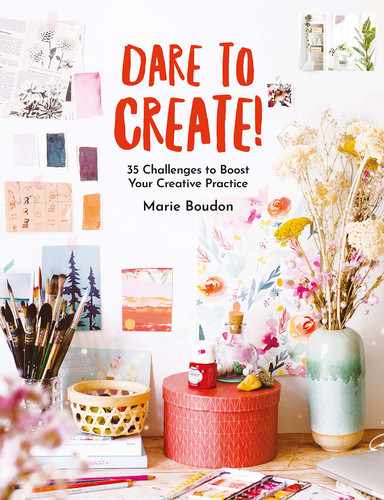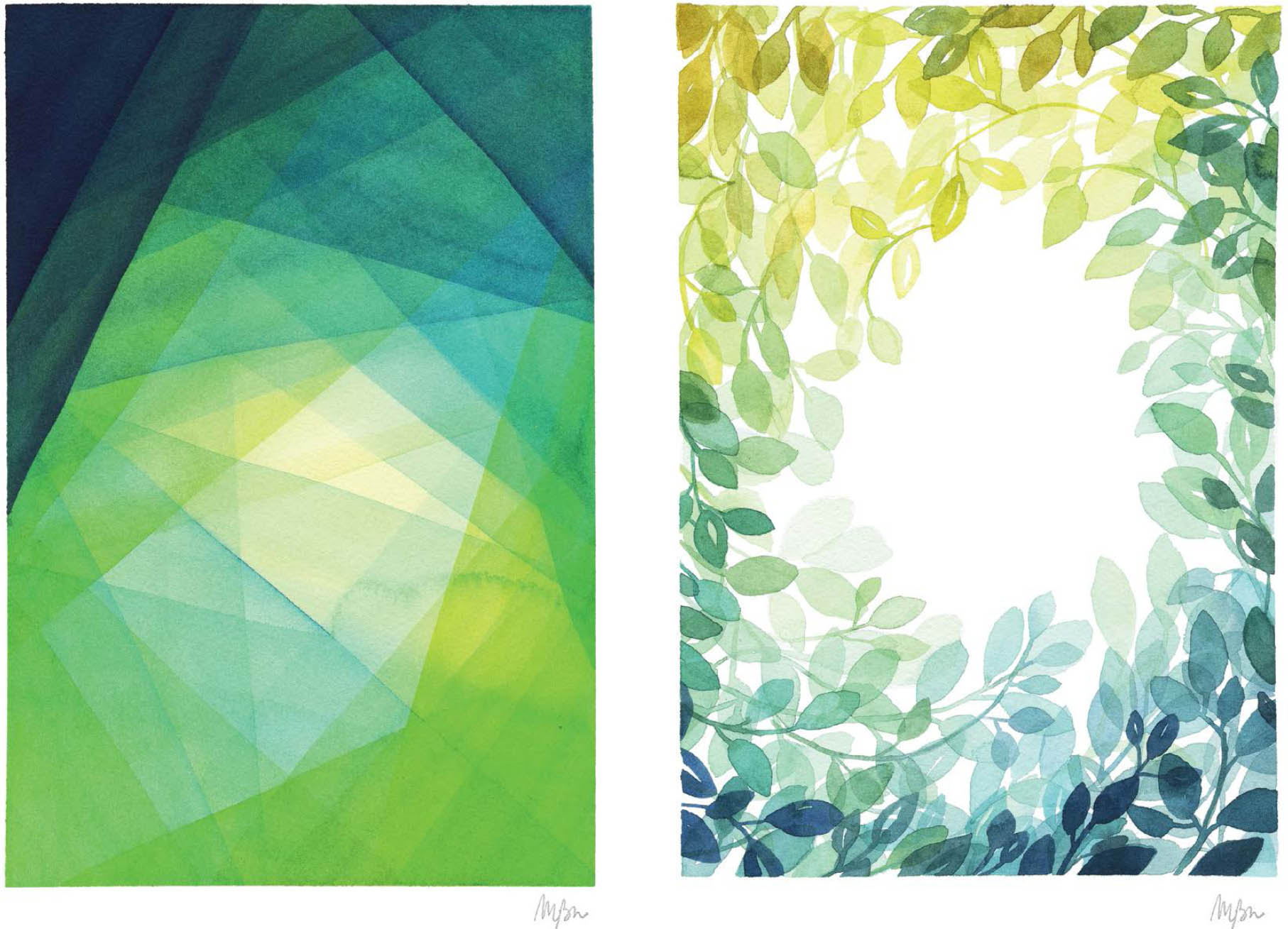 CHALLENGE 20
CHALLENGE 20 
Evaluating Your practice
WITH THIS FOURTH PART, YOU HAVE BEGUN YOUR CREATIVE PRACTICE BY WORKING ON THE TECHNICAL BASICS. AT THIS STAGE, IT ISN’T EASY TO EVALUATE WHETHER OR NOT YOU HAVE IMPROVED, AND THAT CAN BE DISCOURAGING (CHALLENGE 32). IN THIS CHALLENGE, YOU WILL FIND THE ADVICE YOU NEED IN ORDER TO GET SOME PERSPECTIVE ON YOUR LEARNING PROCESS AND DETERMINE THE BEST EXERCISES FOR YOU BY WAY OF THREE QUESTIONS. LOOKING AT YOUR PRACTICE WITH A CRITICAL EYE IS AN IMPORTANT STEP THAT WILL INCREASE YOUR MOTIVATION AND PUSH YOUR ART IN THE DIRECTION OF GREATER EXPRESSION (PART 5).
Do you like this exercise?
Your artistic practice, particularly when you are at the stage of technical exercises, should not feel like torture. Follow your curiosity and your tastes: what techniques do you find intriguing? What do you enjoy the most? What makes you happy? Follow the directions that these lead you in. Your learning process is a way for you to gain confidence and gradually make you want to express yourself (part 5). If you like what you’re doing, you won’t even notice the passage of time and you will be able to tolerate mistakes and failures much more easily. Don’t force yourself to do things that you don’t like; otherwise, you may get bored and lose your motivation.
Is this exercise easy or hard?
Putting aside the question of the result (whether or not you think it is a success), was the exercise easy or hard to finish? I would suggest that you lean towards small, easy exercises. There is no point in forcing yourself to tackle large, impossible tasks: that’s ambitious, but daunting. Break a hard exercise down into small steps, or build up to the difficulty a little bit at a time. For example, if you want to learn how to paint a landscape, start by practicing painting clouds, rocks, and water effects separately, then put them all together at the end (challenge 16). This will allow you to have a series of small successes, which will stimulate your progress. If you break things down this way, then after a few practice sessions, you will be totally able to succeed at exercises that seemed too hard when you started.
Does this exercise use your strengths or your weaknesses?
The difficulty of the exercise and how hard it is for you to manage it are two different things. Try to be objective about your strengths and weaknesses. Then you will be able to ask yourself: should I be working on my strengths or on my weaknesses?
![]() Working on your strengths: If you are at the beginning of your practice, in a phase of discovery, make a point of using and working with your strengths. For me personally, one of my strengths is painting watercolor flowers. At the beginning of my practice, I decided to concentrate entirely on this subject instead of going in a lot of different directions. But people kept telling me, “Paint something else for once!” I concentrated on my strength and, building up my confidence, was able to quickly learn a whole set of techniques that I now use for other subjects as well. Marcus Buckingham, the British writer and motivational speaker, says: “If you only work on your weaknesses, that will pull you down and, at the very best, result in small improvements. Instead, you should think of your weaknesses as what they are, things that weaken you, and find ways to work around them.”
Working on your strengths: If you are at the beginning of your practice, in a phase of discovery, make a point of using and working with your strengths. For me personally, one of my strengths is painting watercolor flowers. At the beginning of my practice, I decided to concentrate entirely on this subject instead of going in a lot of different directions. But people kept telling me, “Paint something else for once!” I concentrated on my strength and, building up my confidence, was able to quickly learn a whole set of techniques that I now use for other subjects as well. Marcus Buckingham, the British writer and motivational speaker, says: “If you only work on your weaknesses, that will pull you down and, at the very best, result in small improvements. Instead, you should think of your weaknesses as what they are, things that weaken you, and find ways to work around them.”
Some of my favorite watercolor exercises, which I have worked on a lot: peonies, anemones, creating color charts to study water proportions, color fusion, and finding harmonious palettes.
Some other examples of exercises that matched the criteria of this challenge for me when I was trying to get better at transparency and depth in watercolor painting.
![]() Working on your weaknesses: Later, once you feel comfortable with the technical basics, come back to your weaknesses. For instance, my weaknesses in watercolor painting are landscapes, people, and architecture. Now that I have a better foundation, I do try to work on these areas, and I learn a lot from that. If exploring your weaknesses interests and intrigues you, then working on them will take you out of your comfort zone (see Fran Meneses’s personal story on page 182).
Working on your weaknesses: Later, once you feel comfortable with the technical basics, come back to your weaknesses. For instance, my weaknesses in watercolor painting are landscapes, people, and architecture. Now that I have a better foundation, I do try to work on these areas, and I learn a lot from that. If exploring your weaknesses interests and intrigues you, then working on them will take you out of your comfort zone (see Fran Meneses’s personal story on page 182).
Good practices
In summary, your practice should concentrate on exercises that combine:
![]() fun: if you’re not having fun, you will lose your motivation over the long term;
fun: if you’re not having fun, you will lose your motivation over the long term;
![]() an acceptable level of difficulty: it is better to do small, quick exercises that are easier to repeat and that don’t use up all of your energy;
an acceptable level of difficulty: it is better to do small, quick exercises that are easier to repeat and that don’t use up all of your energy;
![]() learning about and using your strengths: at least in the discovery phase of your artistic practice;
learning about and using your strengths: at least in the discovery phase of your artistic practice;
![]() repetition: as long as you are still learning something from the exercise.
repetition: as long as you are still learning something from the exercise.
As in many parts of life, twenty percent of the exercises will be responsible for eighty percent of your results (corresponding to the principle of the French-Italian economist and sociologist Pareto, who has stated that 80 percent of effects are due to 20 percent of causes). Therefore, you should concentrate on the part of your learning process that creates the most value. I do not recommend, at this stage, asking for a critique of your work or an evaluation of your strengths and weaknesses. A negative opinion could heavily damage your confidence (challenge 35). Instead, use your own introspection and remember that there is no one right answer.
![]() Your Turn
Your Turn ![]()
Make a complete evaluation of your creative practice, using your creative journal and the following questions.
- 1. List the most recent exercises and experiments that you’ve done.
- 2. What did you like the least? What was hardest for you? Which exercises did not use your strengths? Which were too repetitive? Eliminate these exercises from your practice.
- 3. Review the list of the skills that you want to develop (challenge 15). Are you seeing progress in these skills? Do you want to work on something new? If so, think about what new exercises you should try out.
- 4. Review your organizational systems (routines, goals, schedule, etc.). Can you optimize them, or adapt them so that you can create more easily?
- 5. Do you feel like your skill base is solid enough for now? Why not start working on projects that are more complete and more personal? If that is the case, then it is now time to move on to part 5.


